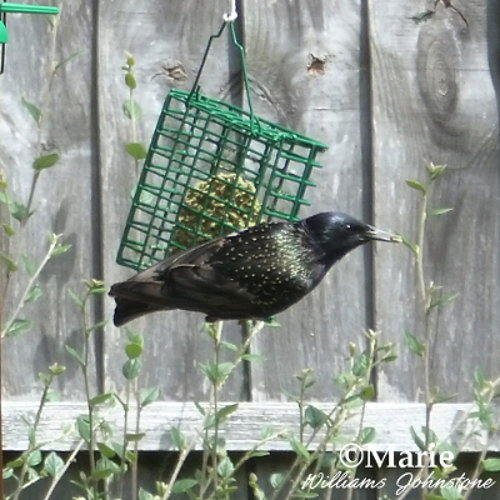Attracting Birds to Feeders All Year Round

I assumed that it would be easy to attract birds into the garden after putting some feeders up. We filled them all up with seeds and I thought that would be enough. Unfortunately it's not that simple. Encouraging and attracting birds to feeders in order to eat in your outdoor space can take days, weeks or even months of patience.
It was 6 weeks before any bird came to feed. The whole episode was very disheartening. Unless we'd been particularly determined, we might have just given up on the idea entirely. Reading about our experience should help you to avoid our mistakes and have a better idea on what to expect. Discover how to get birds feeding in your garden - in the winter and all year round.
Note: This post may contain affiliate links for which I can be compensated.
Attracting Birds to Feeders Did Not Get off to a Flying Start
When we envisaged making a garden that would attract and encourage local birds in, we did not consider that it might take a long time. We thought that by putting out some seed and tasty treats like suet, a variety of birds would come flocking in. It didn't work anything like that.

Image Credit: photo belongs to the author.
The first bird feeding table that we put up was initially used as an emergency landing post by our local Wood Pigeons. This photo was from the second day. We made the DIY wood feeder ourselves and hung seeds, suet and water from it.
Even though we'd attracted a pigeon and not smaller songbirds as I had expected, I was still excited at this point. A bird in our garden was like a miracle. Before this, our back yard was a boring bit of grass with a single Cotoneaster shrub. The birds ignored our boring bit of land for the much more interesting plots in the neighborhood.
Over the following week, I saw pigeon after pigeon using our new table as a handy landing strip. Some of them were inquisitive about the food hanging underneath but they were unable to get to it. It was a bit of a frustrating time. If we hadn't been really determined to encourage the birds in, I'm sure we'd have quit. It took 6 long weeks before we noticed any food being eaten at all.
After 6 Weeks, We Attracted Our First Feeding Birds

Image Credit: photo belongs to the author.
It seems that patience is key with backyard birding. Not everybody likes Starlings because they fly and eat in very large groups. We've had as many as 15 that I've counted around our feeders in one go although normally it's more like 4-5. They are noisy and can scare away smaller and more timid birds.
Here in the UK, Starlings are on the RSPB red alert list because of dwindling numbers. So it was great to see them come and eat from our supply of food. Over the months and years of watching them, I've grown increasingly fond of these birds. It's great fun to watch them land up on the homes behind our garden. They land on the roofs, one by one and then have a good look round before swooping down on our feeders in a noisy rabble.
Starlings squabble over food. They seem to do this out of a natural behavior since they still squabble even when there is more than enough food to go around. We offer them fat balls as well as suet cakes and blocks which they love. They are loud and feisty to listen to.
From a distance they just look like they have plain black feathers. However, they have the most beautiful plumage with a sparkling rainbow sheen when you see them close-up.
Why Did it Take so Long to Get Birds and How to Attract Birds into Your Garden
Thinking back to when we started, I now have a good idea why it took so long to encourage birds to eat. Our backyard was, at that time, really boring from a bird's point of view. It has definitely improved since then with the addition of a wild patch of land.
When we were first trying to encourage the birds to eat, we had a closely cropped lawn and a single Cotoneaster shrub. It had very little available to attract wildlife.
To think that we could just put some food out and that suddenly our back garden would turn into a bird lover's paradise was ignorant. A garden lacking in wildlife is of no real interest to these creatures.
We now enjoy seeing a whole range of British birds and some of these include in rough order of their appearance: wood pigeons, collared doves, starlings, blackbirds, thrushes, sparrows, robins, goldfinches, greenfinches, wrens, dunnocks, chaffinches, blue tits and the occasional magpie.
Just outside our home we have a large park lined with trees. In the park we often see carrion crows, ravens, jackdaws, magpies, green woodpeckers and seagulls. We are very keen to encourage the woodpeckers in to feed. Having food out during a harsh winter may help to encourage this shy bird.
Tips on Attracting Birds to Your Own Feeders in the Winter and All Year Round

Image Credit: photo belongs to the author.
1: Offer a Variety of Food
Different types of birds enjoy a variety of foods depending on what's available in the neighborhood. For instance, our sparrows enjoy the wild bird seed mix but the starlings never touch it. Starlings prefer our fat balls and suet cakes. The goldfinches really like the sunflower hearts. Robins love the dried mealworms. Pigeons and doves eat the mixed seed and sunflower hearts that drop to the grass.
It will take experimentation, time and patience because what works for one person may not work for someone else. It could be to do with what is already available to eat by the birds in your local area.
Robins, starlings and other songbirds will eat dried mealworms from us with relish.
All over the Internet I kept reading reviews on how dried mealworms were useless and that birds did not like them. I bought them anyway and experimented. Offered dry, as they normally come, they're not a great success. We now know to soak them in boiling hot water for a few minutes to soften them up. Drain them and when cool offer out in a hanging dish or in a tray lifted off the ground.
No-melt suet is a favorite with the starlings. I've been very happy with no melt varieties which get devoured quickly. We cut our cakes in half because I think it's best to offer little and often. The no-melt variety are best in warm weather because melting suet cakes can quickly go rancid and spread disease.
2: Space out Bird Feeders
Starlings seem to squabble no matter what. These noisy birds can scare the shyer and smaller varieties away. Building a second wooden bird table, however, and spacing out the hanging food and seeds helped. We also used string to hang feeders at different heights, experimenting to see what works well for us.
3: Offer Food How Birds Prefer to Eat it
Robins did not start coming into our garden until we placed a tray of pre-soaked dried mealworms out for them at a low-level height. Robins can get very greedy for this treat and we put these out in really cold weather. Goldfinches will only feed higher up and not anywhere near the ground. Pigeons are ground feeders and will hang around waiting for stray seeds to drop down.
You might need to experiment with feeding birds at different heights and in different places.
4: Birds Need to Feel Safe to Feed
It's no good placing food where birds might feel vulnerable to the threat of being eaten by a cat or other natural predator. We placed all our feeders slightly out in the open lawn where birds can easily see any approaching threat. However, nearby is a large Cotoneaster shrub that they can quickly dive into for protection.
5: Provide Water for Drinking and Washing
This is a real must-do item and I wish I'd known this sooner. Birds get most of their moisture from food. However, they also need places to bathe which keeps their wings in good condition for flight.
A bird bath placed near the feeding area can really attract birds, especially if there is not much water available nearby. Make the bath shallow so small songbirds can use it too. You do not need to buy a purpose-made bath. A tree stump or an upturned plant pot with a shallow bowl of water fixed on top is great.
You can put big stones in around the edges of a bath to encourage smaller birds to use it. You need to clean it often, especially in hot weather when it gets dirty quicker. Dirty water can pass diseases to the birds using it.
Backyard Birding Requires Patience and Persistence
I wish I'd known sooner about how much birds like having baths near their feeding area. It gives them a place to drink and to wash their feathers out. Since shallow water is necessary for smaller birds, we placed large stones round the edges.
It's quite funny watching the plump pigeons bathing in these because they almost fill it up. Sometimes they just sit in there with water spilling over the edge.
Bearing these tips in mind, it should not take you as long as 6 weeks to attract some feathered friends in to eat.
Related Content You Should Also Love:
Page Last Updated:



Comments
Post a Comment
CraftyMarie is a craft themed website by Marie Williams Johnstone. I love to craft in the winter and garden in the summer. I make handmade cards, papercrafts, crochet and seasonal crafts. I enjoy many of the more traditional crafts and hobbies including sewing, embroidery and working with felt and fabric. Thanks for leaving me a comment. Comments do not show up until I approve them. Marie